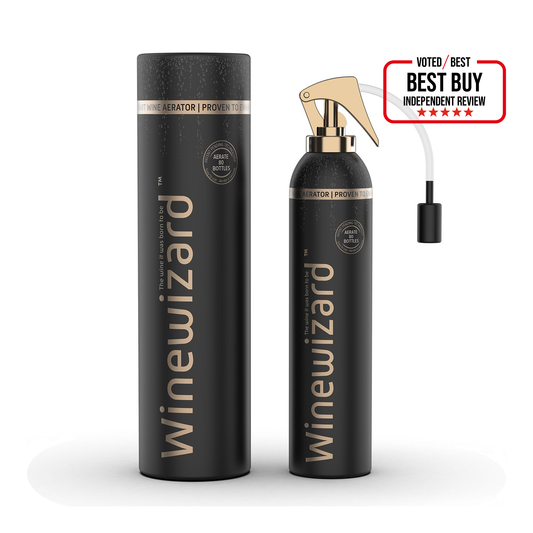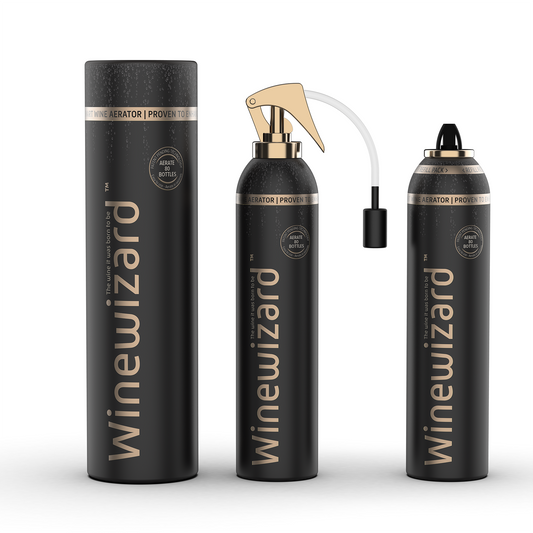Sulfite Reduction in Wine With Winewizard.
A short introduction to sulfites, how and why they are added to wine, what are their effects and how Winewizard technology can neutralise them.
What are sulfites?
Sulfites, in the context of wine, refer to sulfur dioxide (SO2) and its various forms. Sulfur dioxide is a chemical compound that contains sulfur and oxygen and is widely used in winemaking. It serves several important purposes in the wine industry, including:
- Antioxidant: Sulfur dioxide is used as an antioxidant to protect wine from oxidation. It helps preserve the wine's freshness and prevent it from turning brown or losing its flavor due to exposure to oxygen.
- Antimicrobial: Sulfur dioxide is a powerful antimicrobial agent that inhibits the growth of spoilage microorganisms, such as yeasts and bacteria, that can negatively affect the wine's quality.
- Clarifying Agent: Sulfur dioxide can assist in the clarification and stabilization of wine, helping to remove unwanted particles and proteins that might make the wine appear hazy.
Why add them to wine?
Sulfur dioxide (SO2) is commonly added to wine during the winemaking process to prevent oxidation, inhibit the growth of spoilage microorganisms, and protect the wine from unwanted chemical reactions. It is an important tool for ensuring the quality and stability of the final wine.
How are they added to wine?
There are a few common methods for adding sulfur dioxide to wine:
- Sulfur Dioxide Gas: Gaseous sulfur dioxide is one of the most controlled and precise ways to add SO2 to wine. Winemakers can use specialized equipment to introduce a precise amount of SO2 gas to the wine in a controlled manner.
- Sulfur Dioxide in the Form of Campden Tablets or Powder: Campden tablets or potassium metabisulfite powder are readily available sources of sulfur dioxide. Winemakers can crush the tablets or dissolve the powder in a small amount of water and then add this solution to the wine. The amount added can be measured based on the desired level of free SO2.
- Sulfur Dioxide in Liquid Form: Some winemakers use a prepared liquid solution of sulfur dioxide to add to their wine. This liquid solution is often used for larger batches and is more convenient for ensuring accuracy in dosage.
- Burning Sulfur Wicks: In some traditional winemaking methods, sulfur wicks are ignited and then placed in a wine barrel or container. The burning wick produces sulfur dioxide gas, which is released into the wine to sanitize and protect it.
What’s the chemistry of sulfur in wine?
The chemical reactions involved in the conversion of sulfur dioxide (SO₂) to sulfite (SO₃²⁻) and then to sulfate (SO₄²⁻) in wine are as follows:
Sulfur Dioxide (SO₂) to Sulfite (SO₃²⁻):
SO₂ + H₂O ⇌ HSO₃⁻ ⇌ SO₃²⁻
Sulfur dioxide (SO₂) can exist in wine in equilibrium with sulfite (HSO₃⁻) and bisulfite (SO₃²⁻). The exact proportions of these species depend on factors like pH and temperature.
Sulfite (SO₃²⁻) to Sulfate (SO₄²⁻):
2 HSO₃⁻ + O₂ ⇌ 2 HSO₄⁻
Sulfite ions (HSO₃⁻) can be further oxidized to form sulfate ions (HSO₄⁻). This oxidation process usually occurs over time, especially in the presence of oxygen.
Sulfites regulation in wine and human health.
Sulfites are regulated in wine for several important reasons:
- Allergen Sensitivity: Some individuals are sensitive or allergic to sulfites, and consuming wines with high sulfite levels can trigger adverse reactions such as allergic responses, asthma, or headaches. Regulations require disclosure of sulfite content on wine labels to alert consumers who may be sensitive to sulfites.
- Consumer Safety: Sulfites, especially at high levels, can be harmful to certain individuals, particularly those with sulfite allergies. Regulatory oversight ensures that wine producers adhere to safe levels of sulfite use to protect consumer health.
- Label Transparency: Regulating sulfites in wine ensures that consumers have access to important information about the content of additives in the wine they purchase. This transparency allows consumers to make informed choices based on their dietary restrictions or health concerns.
- Quality Control: Sulfites are widely used in winemaking to protect wine from oxidation, spoilage microorganisms, and unwanted chemical reactions. Regulations help maintain wine quality by ensuring that sulfites are used in appropriate amounts and under controlled conditions.
How does Winewizard technology neutralise the sulfites in wine?
As can be seen from the equations above sulfites transform to harmless sulfates with the addition of Oxygen. This process is normally a slow one. However, using precise microquantities of oxygen and a super massive surface area allow this reaction between the SO3 and O2 to happen almost instantly, significantly converting the sulfites to natural, harmless sulfates.
Winewizard Equation
2 HSO₃⁻ + Ww ⇌ 2 HSO₄⁻
Ww=Winewizard patent pending air gas mixture.
What is the proof that reducing sulfites in wine leads to a reduction in wine induced headaches?
There have been several papers written on the subject. The largest study was conducted by Health Sciences Research Centre, University of Beira and published in European Journal of Clinical Nutrition in April 2019. Its conclusions were, “…. sulfite concentration in wine is related to the risk of developing headaches in individuals who are susceptible to wine induced headaches.’ Full publication here: European Journal of Clinical Nutrition (2019) 73:1316–1322 https://doi.org/10.1038/s41430-019-0420-2







